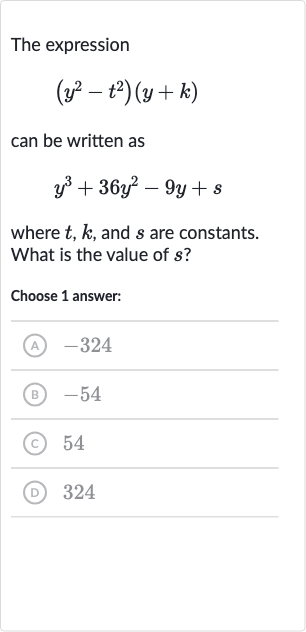Full solution
Q. The expression can be written as where , and are constants. What is the value of ?Choose answer:(A) (B) (C) (D)
- Factorize Difference of Squares: We need to expand the expression to find the value of .
- Expand and Compare Expressions: First, recognize that is a difference of squares and can be factored into .
- Identify Coefficients: Now, distribute across to get the expanded form.
- Eliminate Terms: Expand to get .
- Find Constant Term: Expand to get .
- Find Constant Term: Expand to get .Combine the terms to get the full expanded expression: .
- Find Constant Term: Expand to get .Combine the terms to get the full expanded expression: .Now, compare the expanded expression to . We see that the coefficient of in the expanded expression is , which must equal from the given expression.
- Find Constant Term: Expand to get .Combine the terms to get the full expanded expression: .Now, compare the expanded expression to . We see that the coefficient of in the expanded expression is , which must equal from the given expression.The term has no corresponding term in , which means that must be to eliminate the term .
- Find Constant Term: Expand to get .Combine the terms to get the full expanded expression: .Now, compare the expanded expression to . We see that the coefficient of in the expanded expression is , which must equal from the given expression.The term has no corresponding term in , which means that must be to eliminate the term .With being , the term also disappears, leaving us with as the only terms with and .
- Find Constant Term: Expand to get . Combine the terms to get the full expanded expression: . Now, compare the expanded expression to . We see that the coefficient of in the expanded expression is , which must equal from the given expression. The term has no corresponding term in , which means that must be to eliminate the term . With being , the term also disappears, leaving us with as the only terms with and . Since there is no term in , must also be to eliminate the term .
- Find Constant Term: Expand to get .Combine the terms to get the full expanded expression: .Now, compare the expanded expression to . We see that the coefficient of in the expanded expression is , which must equal from the given expression.The term has no corresponding term in , which means that must be to eliminate the term .With being , the term also disappears, leaving us with as the only terms with and .Since there is no term in , must also be to eliminate the term .Now we know that and , so the term in the expression is the constant term left over, which is .
- Find Constant Term: Expand to get .Combine the terms to get the full expanded expression: .Now, compare the expanded expression to . We see that the coefficient of in the expanded expression is , which must equal from the given expression.The term has no corresponding term in , which means that must be to eliminate the term .With being , the term also disappears, leaving us with as the only terms with and .Since there is no term in , must also be to eliminate the term .Now we know that and , so the term in the expression is the constant term left over, which is .Substitute and into to find .
- Find Constant Term: Expand to get .Combine the terms to get the full expanded expression: .Now, compare the expanded expression to . We see that the coefficient of in the expanded expression is , which must equal from the given expression.The term has no corresponding term in , which means that must be to eliminate the term .With being , the term also disappears, leaving us with as the only terms with and .Since there is no term in , must also be to eliminate the term .Now we know that and , so the term in the expression is the constant term left over, which is .Substitute and into to find . However, we made a mistake. We should have compared the constant terms directly instead of assuming and are zero. Let's correct this by comparing the constant term from the expanded expression to the constant term in the given expression .
More problems from Transformations of quadratic functions
QuestionGet tutor help
QuestionGet tutor help
QuestionGet tutor help
QuestionGet tutor help
QuestionGet tutor help
QuestionGet tutor help
QuestionGet tutor help
QuestionGet tutor help

